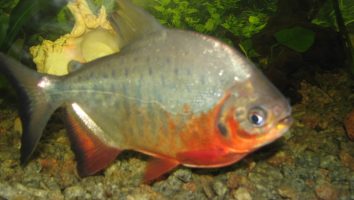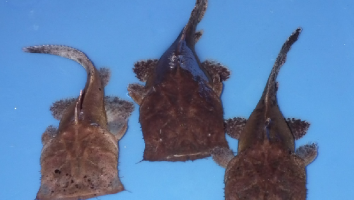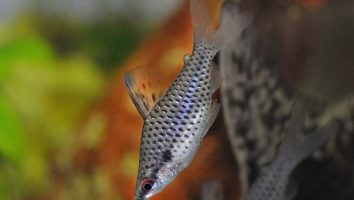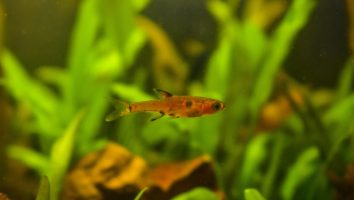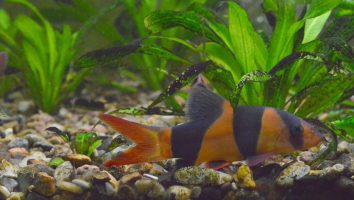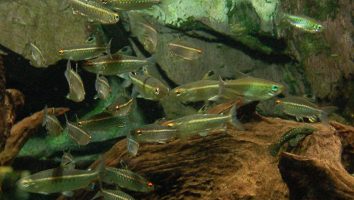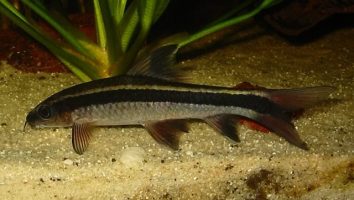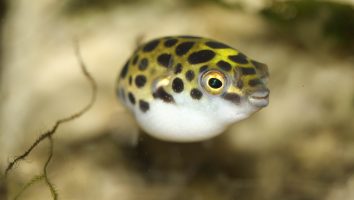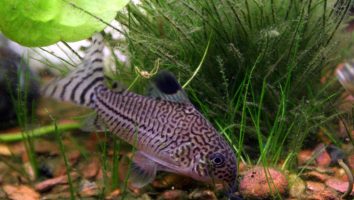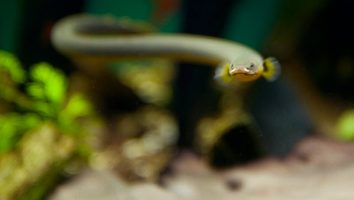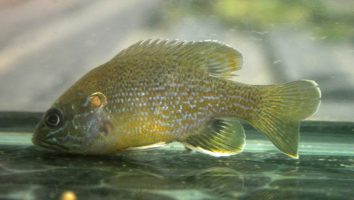Dwarf Mbuna are a beautiful and easy to care for freshwater fish that make a great addition to any aquarium.
This species is peaceful and relatively low-maintenance, and they’re also one of the best beginner cichlids out there.
But there’s a lot of misinformation out there when it comes to this fish. We’ve read so many conflicting suggestions on care and tank mates over the years!
So we made this guide to set the record straight. In it, you’ll learn the correct Dwarf Mbuna care guidelines (and tips on how to breed them).
Table of contents
Species overview
Dwarf Mbunas (Pseudotropheus demasoni) are a type of cichlid that’s native to Lake Malawi in Africa.
They are found in the southern and southeastern regions of the lake, primarily near the Tanzanian coast.
Dwarf Mbunas are known for their small size (hence the name) and their vibrant colors. They are one of the more popular cichlid species due to their beauty and relatively peaceful nature.
In the wild, these fish are mostly herbivores but will occasionally eat small invertebrates. In the aquarium, they should be given a diet that’s heavy in vegetables with the occasional live or frozen food.
Compatibility-wise, Dwarf Mbunas can be kept with other Mbuna cichlids as well as some peaceful Tanganyikan cichlids. Avoid putting them with larger, more aggressive fish.
Appearance
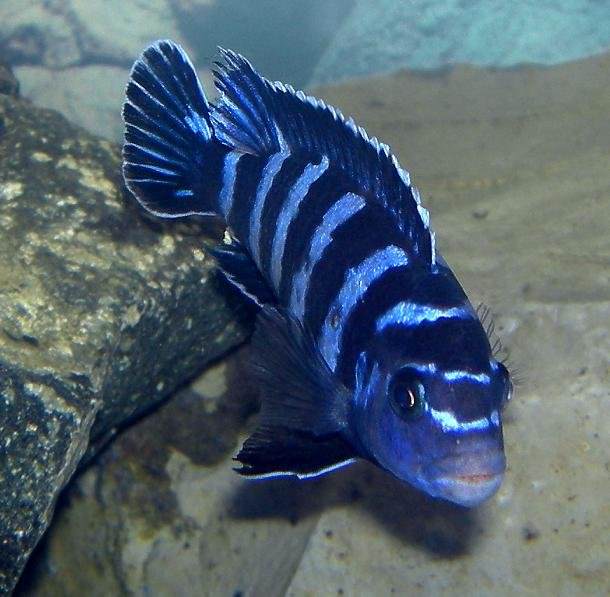
Dwarf Mbunas are one of the more colorful freshwater fish that you’ll find. They have a dark blue body with light blue stripes running horizontally along their sides.
The blue isn’t the only color on these fish though. You’ll also find hints of yellow, orange, and red as well. These colors are most often on the fins and tail of the fish.
The body of the Dwarf Mbuna is elongated and compressed. This gives them a very sleek appearance that helps them zip through the water with ease.
Their fins are all moderately sized with the exception of their dorsal fin. This fin is rather large and extends almost the entire length of their body.
The caudal fin is forked and symmetrical. The pectoral fins are rather small in comparison to the rest of the body.
Lifespan
The average lifespan of a dwarf mbuna is around 5 years. However, with proper care, they can live up to 10 years in captivity.
One of the main things that affects the lifespan of these fish is water quality. If the water is not clean then they will not live as long as they could.
Another factor that can affect their lifespan is aggression. If they are constantly fighting with other fish then this will also shorten their lifespan.
Size
Although they can grow up to 5 inches, most Dwarf Mbuna only grow to be around 3 inches in length when fully matured.
Tank
Tank Size
The minimum recommended tank size for a dwarf mbuna is 10 gallons. However, we recommend going with a larger tank if you can. 20 gallons is ideal, and anything larger than that is even better.
The reason for this is that mbunas are very active fish. They’re constantly swimming and exploring their territory. A larger tank will give them the room they need to stay healthy and happy.
Water Parameters
Mbuna are a hardy bunch that do well in a wide range of water parameters. They’re native to the rocky shores of Lake Malawi, where they live in waters with a high mineral content.
This is reflected in their ideal water parameters. They prefer a high pH and hardness, with alkalinity on the lower end of the spectrum.
One thing to keep in mind is that these fish are accustomed to living in close quarters with other Mbuna. They’re used to a little jostling and aggression, so don’t be too concerned if they seem a little rough with each other.
Just avoid putting them in a tank with fish that are too small. They may see them as a meal!
- Water Temperature: 75-82 degrees Fahrenheit
- pH Levels: 7.8-8.6
- Water Hardness: 10-25 dGH
- Alkalinity Levels: 4-8 dKH
What To Put In Their Tank
When it comes to setting up the inside of an aquarium for Dwarf Mbuna you can be as creative as you want. There aren’t any specific things that this species NEEDS to have, which gives you plenty of options.
We recommend some of the standard decorations that you find in a lot of freshwater tanks. There are a ton of great plants you can include (like hornwort or water wisteria). You can even throw in some floating aquarium plants too!
Rocks, driftwood, and caves are all suitable as well. It’s important to avoid going overboard with this since these fish like some room to swim.
Also, if you’re keeping your Dwarf Mbuna in a smaller tank then it’s going to be difficult to include a lot of this stuff anyway.
A classic gravel substrate is always a good choice, but you can do with something soft and sandy if needed too (use other species you keep as a guide with this).
Common Diseases
The Dwarf Mbuna is a pretty hearty fish that doesn’t often fall ill. However, that doesn’t mean that they’re immune to disease.
There are a few different illnesses that these fish are prone to, the most common being ich. This is a parasitic infection that will present itself as white spots on the body of your fish.
If left untreated, ich can be deadly. However, it’s relatively easy to treat if you catch it early.
Another disease that these fish are prone to is hole-in-the-head disease. This is another parasitic infection, but it’s not nearly as common as ich.
This disease gets its name from the literal holes that it will leave in the head of your fish. It’s rather gruesome, but it can be treated if you catch it early enough.
The best way to prevent your Dwarf Mbuna from getting sick is to maintain a clean and stable tank. These fish are pretty hardy, but they’re not immune to poor water conditions.
Keep an eye on your fish and be sure to consult your vet if you notice anything out of the ordinary.
Behavior & Temperament
The Dwarf Mbuna is a peaceful fish that does well in a community tank. They are active fish that like to swim and explore their surroundings.
Dwarf Mbuna are not aggressive fish, but they can be territorial. They are known to establish a hierarchy within their group. The dominant fish will often chase and harass the others.
This type of behavior is common and not a cause for concern. It’s just their way of establishing their place in the pecking order.
Dwarf Mbuna are also known to be fin nippers. They may nip at the fins of their tank mates, so it’s best to keep them with other fish that have similar body shapes.
Tank Mates
The best tank mates for Dwarf Mbuna are those that occupy different parts of the water column. These cichlids are territorial and will fight with others that stay in their space.
The good news is that there are plenty of fish that stay in different areas of the tank. You just need to be strategic about your selection.
Here are some species that tend to do well:
- Synodontis Catfish
- Peacock Cichlids
- Yellow Lab Cichlids
- Red Zebra Cichlids
- Kenyi Cichlids
- Electric Blue Johannii Cichlids
- OB Peacock Cichlids
- Pseudotropheus Acei Cichlids
Breeding
Dwarf Mbuna are mouthbrooders, which means the female will carry the eggs in her mouth until they hatch.
To get started, you’ll need to set up a breeding tank that’s at least 20 gallons. The water should be between 78 and 82 degrees Fahrenheit. The pH should be between 7.8 and 8.6.
Once the tank is set up, you can add a few rocks and some plants. Make sure there are plenty of hiding places.
When everything is ready, add one male and two females to the tank. You can usually tell the males apart by their brighter colors and larger size.
The female will lay her eggs on a flat surface, like a rock. Once she’s done, the male will fertilize them. Then, the female will pick them up in her mouth and carry them around until they hatch.
This process takes about two weeks. When the fry are ready to be on their own, the female will spit them out.
You can start feeding the fry small live foods, like brine shrimp. As they grow, you can transition them to flake food.
Conclusion
Dwarf Mbuna are some of the most fun and interesting fish you can keep in your aquarium. They’re active and lively, and their beautiful colors will brighten up your tank.
They’re also relatively easy to care for, which is always a plus.
If you’re looking for a fish that’s a little bit different and will add some excitement to your tank, we highly recommend the Dwarf Mbuna!

